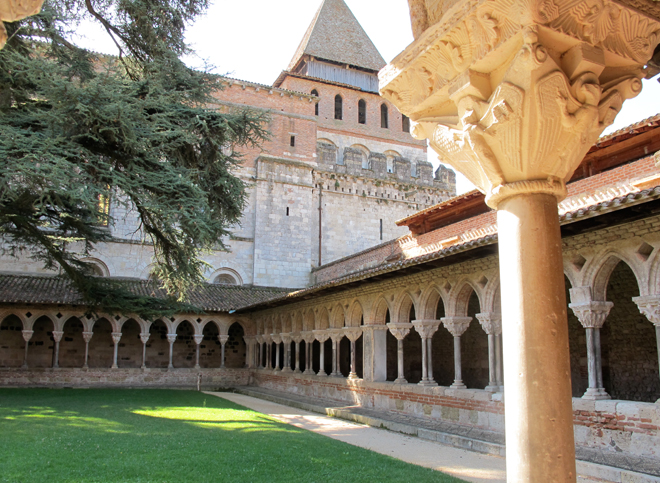

Back and forth, hither and yon – whether on my habitual trajectory between Touraine and Paris or further afield… destinations, encounters, events and observations I can’t resist sharing.

Visiting old friends in Tarn et Garonne, a southern department even the French have difficulty locating. Quercy Blanc is the historic name for this midsection of the Midi-Pyrénées between Cahors and Toulouse. It’s the Tuscany of France, with an undulating landscape of sheep and cattle pasture, sunflower fields, chasselas vineyards and tidy industrial orchards of apricots, plum, cherry and walnut trees. A succession of gorgeous views are revealed at every twist along the sinuous road. The round, green-gold chasselas grape, which is eaten rather than fermented for wine, is the principal crop.
After honing country French renovation skills on a home in the Loire valley, our Australian friends were ready to tackle a seriously daunting project. They fell for an ancient fortified chateau on the plateau of a hill, whose stocky central tower was first ransacked in the 13th century. Successive building campaigns in the 16th, 18th and 19th centuries failed to sustain momentum, and it had declined to a forlorn state of decrepitude. A tailor made challenge for two artists with vision and a history of savvy real estate investments in Sydney, London and Paris to bolster their courage.
After a summer of clearing and cutting overgrown vegetation out of doors, while battling bats, spiders and decades of dust within, they settled into provisional quarters on the ground floor of the tower and are pouring over architect’s plans and a stack of builder’s estimates. We came to take a look before the sale went through last fall and based on progress to date, Chateau M seems destined for a renaissance.
The neighboring market town is Moissac, situated at the confluence of the Garonne and Tarn rivers. For centuries it’s been an important destination for pilgrims on the St Jacques of Compostelle trail, but Moissac came to national attention March 3 1930, when a massive flood decimated much of the town. While stone structures withstood the rising water, many porous brick buildings crumbled. Reconstruction produced numerous Art Deco landmarks along the waterfront and around the central marketplace. Parisians evidently showed solidarity. The cultural center bears the incription “Don de la Ville de Paris 1930” and a stucco frieze below the roofline of a neighboring building responds with “Pour la Ville de Paris”.
The tragedy refocused attention on Moissac’s greatest treasure, the Abbey of St Peter with it’s exquisite romanesque cloister and church portal. The cloister narrowly escaped demolition in the 19th century when a railway line was to be routed through it.
Viollet-le-Duc’s intervention averted a cultural massacre but the refectory and several wings of the monastic complex were razed and tracks graze the perimeter of the cloister. The abbatial church is meticulously restored. Highlights are the south portal’s intricately sculpted tympanum featuring scenes from the Apocalypse of St John, and a polychrome wood sculpture of the Flight to Egypt.
Admission is charged to visit the cloister but is well worth it. Locals boast it’s the world’s most beautiful and I’m willing to agree. Try to time your visit for an off peak tourist moment to fully experience the serenity of the space. Unesco added the cloister and portal to their register of world heritage sites in 1998. The Romanesque masterpiece was completed in 1100. Its 76 sculpted capitals are exceptional both for the quality of the sculpture and the unusual fact that most represent biblical stories or episodes from the lives of the saints. moissac tourism
© Copyright 2024 Casey O’Brien Blondes - Privacy Policy | Design by Weller Smith Design
Do NOT follow this link or you will be banned from the site!
Harriet said
October 14, 2010 at 4:43 amWonderful photography!
Sorry, the comment form is closed at this time.